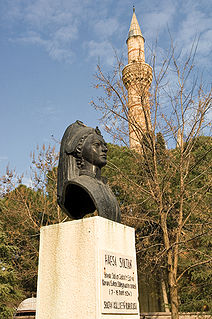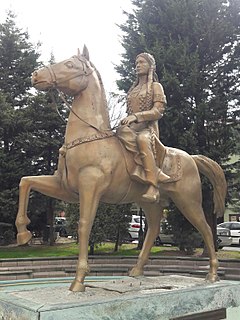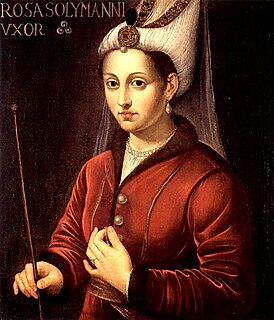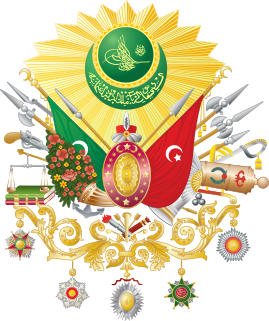
Hurrem Sultan, also known as Roxelana, was the chief consort and wife of the Ottoman sultan Suleiman the Magnificent. She became one of the most powerful and influential women in Ottoman history as well as a prominent and controversial figure during the era known as the Sultanate of Women.

Valide Sultan was the title held by the "legal mother" of a ruling sultan of the Ottoman Empire. The title was first used in the 16th century for Hafsa Sultan, consort of Selim I and mother of Suleiman the Magnificent, superseding the previous title of mehd-i ulya . Normally, the living mother of a reigning sultan held this title. Those mothers who died before their sons' accession to the throne were never bestowed with the title of valide sultan. In special cases sisters, grandmothers and stepmothers of a reigning sultan assumed the title valide sultan.
Nurbanu Sultan was Haseki Sultan of the Ottoman Empire as the principal consort of Sultan Selim II, his legal wife, as well as Valide Sultan as the mother of Sultan Murad III. She was one of the most prominent figures during the time of the Sultanate of Women. Conflicting theories ascribe her a Venetian, Jewish or Greek origin. Her birth name may have been Cecilia Venier-Baffo, Rachel or Kalē Kartanou.

The Imperial Harem of the Ottoman Empire was the Ottoman sultan's harem – composed of the wives, servants, female relatives and the sultan's concubines – occupying a secluded portion (seraglio) of the Ottoman imperial household. This institution played an important social function within the Ottoman court, and wielded considerable political authority in Ottoman affairs, especially during the long period known as the Sultanate of Women. Multiple historians claim that the sultan was frequently lobbied by harem members of different ethnic or religious backgrounds to influence the geography of the Ottoman wars of conquest. The utmost authority in the Imperial Harem, the valide sultan, ruled over the other women in the household; the consorts of the sultan were normally of slave origin, and thus were also his mother, the valide sultan.

Malhun Hatun was the first wife of Osman I, the leader of the Ottoman Turks and the founder of the dynasty that established and ruled the Ottoman Empire. She was the mother of Sultan Orhan.
Ottoman court was the culture that evolved around the court of the Ottoman Empire.

Hafsa Sultan was the wife or concubine of Selim I and the first valide sultan of the Ottoman Empire as the mother of Suleiman the Magnificent. During the period between her son's enthronement in 1520 and her death in 1534, she was one of the most influential persons in the Ottoman Empire.

Gülüstü Hanım was the nineteenth wife of Sultan Abdulmejid I, and the mother of Sultan Mehmed VI, the last Sultan of the Ottoman Empire.
Aşub Sultan was a consort of Ottoman Sultan Ibrahim and Valide Sultan to their son Suleiman II.
Gülcemal Kadın was the sixth wife of Sultan Abdulmejid I, and the mother of Sultan Mehmed V of the Ottoman Empire.
Kadın was the title given to the imperial consort of the Sultan of the Ottoman Empire towards the beginning of the seventeenth century. The title came into official usage at the end of the century, and remained in usage until the nineteenth and twentieth centuries.

Haseki Sultan was the title used for the chief consort of an Ottoman Sultan. In later years, the meaning of the title changed to "imperial consort". Hürrem Sultan, principal consort and legal wife of Suleiman the Magnificent, was the first holder of this title. The title lost its exclusivity under Ibrahim I, who bestowed it upon eight women simultaneously. The title haseki sultan was used until the 17th century. After that, kadınefendi became the highest ranking title for imperial consorts, although this title was not as prestigious as haseki sultan.
Hatun or Khatun is a female title of nobility and counterpart to "khan" or "Khagan" prominently used in the Turkic Khaganates and in the subsequent Mongol Empire.
Gülfem Hatun (Ottoman Turkish: کلفام خاتون was a lady-in-waiting to Suleiman the Magnificent.
Mahidevran was the concubine of Suleiman the Magnificent of the Ottoman Empire and the mother of Şehzade Mustafa.
Ikbal was the title given to the imperial consort of the sultan of the Ottoman Empire, who came below the rank of kadın.

The Sultanate of Women was a period of extraordinary political influence exerted by wives and mothers of the Sultans of the Ottoman Empire. This phenomenon in the early modern period, approximately between the years 1533 and 1656, began during the reign of Suleiman the Magnificent with his marriage to Hürrem Sultan. These sultanas were either the wives of the Sultan, referred to as Haseki Sultans, or the mothers of the Sultan, known as Valide Sultans. Many of these women were of slave origins, as was expected of the sultanate, since traditional marriage roles were considered too large a risk for the Sultan, who was expected to have no personal allegiances outside his title. During this time, Haseki and Valide Sultans held political and social power, which allowed them to influence the daily running of the empire, as well as requesting the construction of buildings, and philanthropic works, such as Valide Sultan Mosque.

Cariye or Cariyes was a title and term used for category of enslaved women concubines in the Islamic world of the Middle East. They are particularly known in history from the era of the Ottoman Empire, where they legally existed until the mid-19th century.








